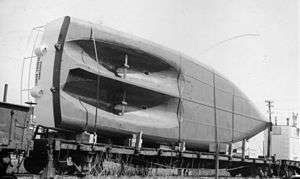Radium Express (ship)
The Radium Express is a Russel Brothers[1] tugboat operated by the Northern Transportation Company.[2][3][4] The vessel was built in Owen Sound, Ontario, disassembled, and then shipped by rail to Waterways, Alberta, which was then the terminus of the North American railway grid.
 Hull of Radium Express being shipped to Waterways, Alberta, 1939. | |
| History | |
|---|---|
| Canada | |
| Name: | Radium Express |
| Operator: | Northern Transportation Company |
| Builder: | Russel Brothers |
| Laid down: | 1939 |
| Launched: | 1939 |
| Completed: | 1939 |
| Commissioned: | as Radium Express |
| General characteristics | |
| Displacement: | 88 tons |
| Tons burthen: | 60 tons |
| Length: | 21.94 m (72.0 ft) |
| Beam: | 6.03 m (19.8 ft) |
| Draught: | 2 ft (0.61 m) |
| Installed power: | 100 hp (75 kW) diesel engine |
| Speed: | 9 kn (17 km/h; 10 mph) |
Like the other vessels in the "Radium Line", she was reassembled in Waterways, on the Clearwater River, a tributary of the Mackenzie, and then proceeded down the Athabasca River and Slave River to Fort Smith, and portaged to the lower river, where she could navigate most of the remainder of the extensive Mackenzie River system.
In 1938 the Saskatoon Star-Phoenix reported the vessel was designed to travel at up to 20 knots (37 km/h; 23 mph), faster than the Radium Line's larger vessels, so it could take over tows in regions of particularly rapid current.[5] The Canadian Transportation Agency reported her speed as 9 knots (17 km/h; 10 mph) in 2011.[4]
On November 16, 1945, the Radium Express and the Radium King were caught by freeze up in Yellowknife.[6]
| Gross tonnage: | 88 t |
| Net tonnage: | 60 t |
| Length: | 21.94 metres |
| Breadth: | 6.03 metres |
| Depth: | 1.67 metres |
| Draught: | 0.91 metres |
| Self-propelled power: | 474 brake horsepower |
| Speed: | 9.0 knots [sic] |
In 2005 Atomic Energy of Canada published a study of the toxic legacy of the mining of radioactive ore at Port Radium.[7] According to the report the Radium Express and all the other surviving vessels of the Radium line were found to be free of contamination, with the exception of the Radium Gilbert.[2] The 2005 study said the Radium Express was being stored, in Hay River.
External links
References
- Steve Briggs. (2018). "Russel Brothers Boats Archive". [Steve Briggs].
-
Peter C. Van Wyck (2010). Highway of the Atom. McGill-Queen's Press. p. 36. ISBN 978-0-77358-087-9. Retrieved 2018-01-13.
There is material leakage all along the sides of the Highway, as well as on the vessels and barges used to traverse it. The merchant fleet Radium line: the Radium King, the Radium Queen, the Radium Lad, the Radium Express, and of course, the Radium Gilbert ... and so on. The rest of the list: Cruiser, Prince, Gilbert, Charles, Scout, Yellowknife, Franklin, Dew, Prospector, Trader, Miner.
- "Radium Express". Owen Sound Sun Times. 1939-05-05. Archived from the original on 2012-11-29. Retrieved 2012-10-14.
- "Vessel: Radium Express". Canadian Transportation Agency. 2011-12-22. Archived from the original on 2012-11-29. Retrieved 2012-10-14.
- "Mackenzie Supplies arrive by River Boat". Saskatoon Star-Phoenix. 1938-05-30. Retrieved 2012-10-14.
-
"Boats Are Caught In North Waters". Edmonton Journal. 1945-11-16. p. 14. Retrieved 2012-05-31.
Both the Radium King and the Radium Express are frozen fast in ice just off Joliffe Island, a stone's throw from the town of Yellowknife. With them are their three barges, being unloaded at the Negus mine dock when freeze-up caught them deciding to make the last short haul as far as Yellowknife's dock, the boats nearly made it, but were caught just a few hundred yards offshore.
-
"Status Report for the Historic Northern Transportation Route redacted colour" (PDF). Atomic Energy of Canada. December 2005. p. 86. Retrieved 2018-01-13.
Ships were used along the NTR to move barges loaded with uranium ore and concentrates (among other materials and supplies). Some vessels also transported cargo on board. Fifteen Radium Series vessels used along the NTR were identified in SENES (1994). Three were determined to have been scrapped, and the disposition of one, the Radium Cruiser, was unknown. Radiological investigations were conducted on the other eleven vessels. Only one, the Radium Gilbert, showed any evidence of contamination.